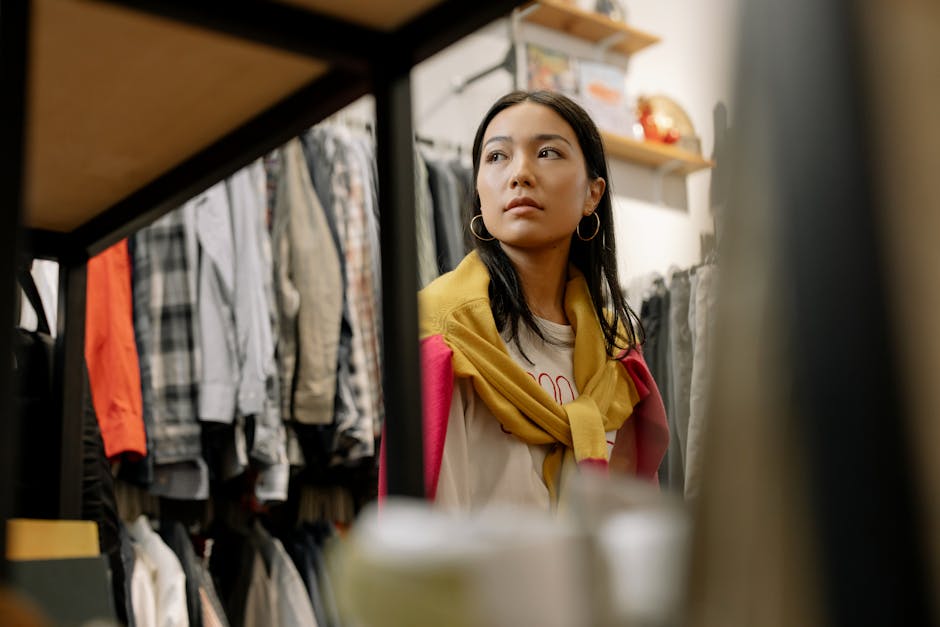Thinking about turning your closet into cash? You’re in the right place.
Whether you have a few pieces gathering dust or a whole wardrobe overhaul planned, selling clothes can be surprisingly rewarding.
It’s not just about decluttering; it’s about making money doing it.
From online platforms to creative upcycling, there’s a method for everyone.
Let’s dive into 18+ easy ways to make money selling clothes that actually work.
Ready to turn your fashion into funds? Let’s get started!
1. Online Marketplaces and Apps
Selling clothes online has never been easier thanks to a variety of apps and platforms tailored specifically for fashion. These sites connect you directly with buyers who are actively looking for secondhand, vintage, or unique items. The convenience of uploading photos and descriptions from your phone makes it a go-to option for many sellers.
Most platforms offer seller protections, shipping tools, and even promotional features to boost your sales. Choosing the right marketplace depends on the types of clothes you’re selling and how hands-on you want to be with the process.
Here are some popular and effective online marketplaces to get your clothes sold fast and hassle-free.
1. Poshmark – This app is a favorite for selling trendy, gently used clothing. Its social media-like interface allows you to follow users, share listings, and participate in “Posh Parties” to increase visibility. The platform handles payment processing, making it simple and secure.
2. Depop – Perfect for vintage and streetwear enthusiasts, Depop blends e-commerce with social networking. The younger user base often looks for unique or retro pieces, so it’s ideal if your clothes fit that vibe. The app encourages creative photos and descriptions to attract buyers.
3. eBay – The classic online auction and sales platform is great for everything from designer pieces to bulk lots. eBay offers flexible selling options, letting you choose auctions or fixed prices, and it reaches a global audience eager for deals.
4. Facebook Marketplace – If you want to sell locally without shipping hassles, Facebook Marketplace is a practical choice. You can list items quickly, communicate with buyers directly, and arrange pick-ups. It’s especially useful for bulkier clothing items.
5. ThredUp – This is a convenient option if you prefer a hands-off approach. ThredUp sends you a “Clean Out Kit” to fill with clothes, and they handle the selling for you. You get paid once your items sell, though the payout is lower since they take care of everything.
Exploring these online marketplaces gives you a solid foundation to start selling clothes with ease and confidence. Next, let’s look at more personal and creative ways to monetize your wardrobe.
2. Local Selling and Community-Based Options
Sometimes, selling clothes face-to-face can be just as rewarding as online sales. Local selling eliminates shipping costs and lets buyers inspect items firsthand, which often leads to quicker sales. Plus, engaging with your community can be a nice way to declutter and connect.
From garage sales to consignment shops, there are plenty of routes to reach buyers close to home. These options can be especially effective if you want to move items quickly or avoid the hassle of packaging and mailing.
Here are some local selling methods to consider.
6. Garage Sales or Yard Sales – A classic way to sell clothes in your neighborhood. Organize a sale and advertise locally to attract bargain hunters. Group clothes by size or style to make browsing easier and offer bundle deals to encourage bulk purchases.
7. Consignment Stores – Local consignment shops accept quality, gently used clothing and sell it on your behalf. You typically receive a percentage of the sale price, which means less upfront work but a share of the profits. It’s great for designer or brand-name items.
8. Flea Markets – Setting up a booth at a flea market can be a fun way to sell clothes and meet other sellers. It requires some initial investment for booth fees but offers a lively atmosphere and a diverse customer base looking for unique finds.
9. Community Facebook or Nextdoor Groups – Many neighborhoods have online groups where residents buy and sell items. Posting your clothes here taps into a trusted community and often results in quick, local transactions without fees.
10. Pop-Up Shops or Local Markets – If you have a larger quantity or a specific niche, consider renting space at a pop-up event or craft market. These venues attract shoppers looking for curated selections and support local sellers, giving you exposure and sales opportunities.
Local selling taps into your immediate community and can be a refreshing, social way to earn money. Now, let’s explore how you can add value to your clothes to increase their selling potential.
3. Upcycling and Customization
Sometimes, the best way to make money from clothes is to transform them. Upcycling and customization add uniqueness and value to garments that might otherwise be overlooked. This creative route lets you tap into a market of buyers seeking one-of-a-kind pieces.
Not only does this approach help the environment by reducing waste, but it also allows you to showcase your style and skills. Even simple alterations can make a huge difference in appeal and price.
Here are some ways to upcycle and customize clothes to boost your earnings.
11. Embroidery and Patchwork – Adding embroidered designs or patches can turn a plain item into a trendy, personalized piece. This is especially popular on denim jackets, jeans, and tote bags. It requires minimal investment but can significantly increase value.
12. Tie-Dye and Fabric Painting – These colorful techniques are back in style and can refresh old tees, hoodies, and dresses. Experiment with patterns and colors to create eye-catching designs that attract buyers looking for something fresh and fun.
13. Tailoring and Resizing – Altering clothes to fit modern trends or different body types can make them more marketable. For example, turning oversized shirts into cropped tops or hemming dresses to current lengths appeals to fashion-forward buyers.
14. Adding Unique Buttons or Zippers – Small hardware changes can give garments a new look. Replacing boring buttons with vintage or decorative ones or adding zippers can make clothes stand out in listings and in-person sales.
15. Patch Repair and Distressing – Instead of throwing away clothes with holes or wear, repair them creatively or add intentional distressing for a grunge or vintage vibe. This technique attracts buyers who appreciate character and sustainable fashion.
Customizing your clothes not only makes them more desirable but also lets you enjoy the selling process. Next, we’ll discuss how to maximize profits through strategic pricing and marketing.
4. Pricing Strategies and Marketing Tips
Setting the right price and marketing your clothes effectively are key to making consistent sales. It’s about balancing what buyers are willing to pay with your profit goals. Smart pricing and promotion can make your listings stand out and attract the right audience.
Marketing your clothes well involves good photos, detailed descriptions, and engaging communication. The more professional and approachable you appear, the more trust you build with potential buyers.
Here are some tips to price and market your clothes like a pro.
16. Research Comparable Listings – Before pricing, check similar items on your chosen platform to see what they sell for. This benchmarking helps you set competitive prices that attract buyers while ensuring you don’t undersell your items.
17. Offer Bundle Discounts – Encourage buyers to purchase multiple items by offering deals like “3 for $20.” Bundles increase your average sale size and help you move inventory faster.
18. Use High-Quality Photos – Clear, well-lit images from multiple angles show off your clothes’ true condition and details. Natural light and simple backgrounds help your listings look professional and trustworthy.
19. Write Detailed, Honest Descriptions – Highlight fabric, size, condition, and any flaws upfront. Transparency builds buyer confidence and reduces the chances of returns or disputes.
20. Engage with Potential Buyers – Respond promptly to questions and be polite and helpful. Good communication can tip the scales in your favor and lead to repeat customers.
Effective pricing and marketing boost your chances of selling quickly and profitably. Now, let’s explore some creative and less conventional ways to monetize clothes.
5. Alternative and Creative Selling Methods
Not every method of selling clothes has to be traditional. Thinking outside the box can uncover new opportunities to earn money while having fun or building a brand. These approaches often require a little extra effort but can pay off in unique ways.
Whether it’s leveraging social media, partnering with local businesses, or starting your own mini clothing line, creativity opens doors. Here are some alternative ideas to consider.
21. Start a Clothing Subscription Box – Curate themed clothing boxes from your inventory and send them to subscribers monthly. This model provides recurring income and builds a loyal customer base who love surprises and style refreshes.
22. Host Clothing Swaps with a Fee – Organize local swap events where participants pay a small entry fee to exchange clothes. You can keep a percentage of the proceeds or sell leftover items afterward for profit.
23. Collaborate with Local Stylists or Influencers – Partner with fashion professionals who can promote your clothes to their audience. This can increase your reach and credibility, especially if you offer unique or high-quality pieces.
24. Create and Sell Digital Lookbooks – Use your clothes to create styled outfit guides and sell them as digital downloads. This appeals to buyers who want fashion inspiration along with their purchases.
25. Rent Out Clothes for Special Occasions – Instead of selling, offer rental options for formalwear or statement pieces. This method generates ongoing income and taps into the growing market of sustainable fashion rentals.
These creative methods round out the many ways you can make money selling clothes, turning your wardrobe into a versatile source of income.
From digital marketplaces to local events, customization, smart pricing, and innovative ideas, there’s something for everyone ready to profit from their clothes. Now, let’s wrap this up.
Remember, selling clothes is both an art and a science—combine creativity with strategy for the best results.
Start small, stay consistent, and watch your efforts turn into earnings.
Now that you’ve got the tools, it’s time to turn those clothes into cash!



